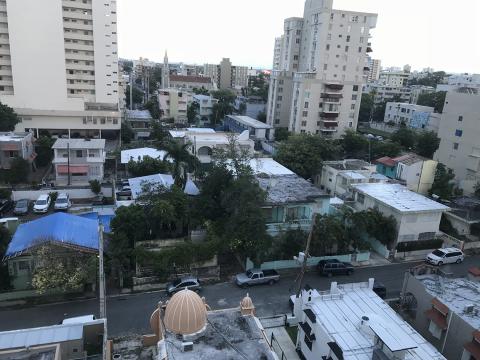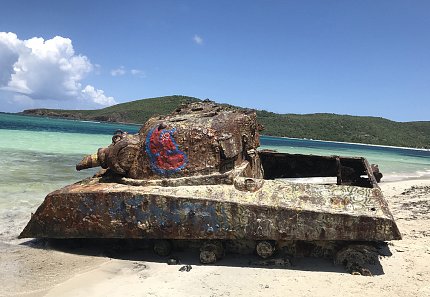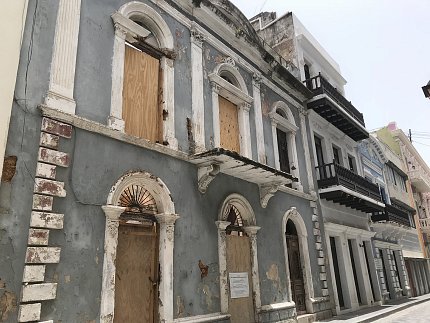NIMH Volunteers Help Out in Post-Maria Puerto Rico

Photo: Susan Borja
On Sept. 20, 2017, Hurricane Maria’s 155 m.p.h. winds slammed into Puerto Rico, downing power lines and flattening buildings. Heavy rains caused catastrophic flooding. For the next 6 months, first-response teams worked to feed and house 3.3 million residents and restore basic infrastructure. Following this emergency response period, FEMA and HHS called for volunteers to help restore essential medical and social services. Several NIMH employees answered the call.
“When I got the email that HHS was looking for volunteers, I signed up right away. I was the first volunteer from the NIMH and I was told to be ready to leave within 24 hours,” recalls Karen Bartholomew, a supervisory social worker in the psychosis and cognitive studies section, who has been a clinician and administrator for more than three decades.
Within weeks of her arrival in March 2018, Bartholomew was asked to take over as chief of the HHS Puerto Rico Behavioral Health Services Branch, a job she held for both of her two tours (March-May, July-August) as an HHS volunteer. Though the branch had been operating for 3 months, she was the first branch chief to have a background in mental health—not to mention in behavioral health services administration.
In her new role, Bartholomew went to universities, hospitals and public agencies, building relations and finding out about the residents’ mental health needs. The bad news was the effects of the hurricane. The good news was that all residents have health insurance, most of the public health clinics that provided psychiatric care had stayed open and the people were remarkably resilient.

Photo: Susan Borja
During her second tour on the island, Bartholomew was asked by the new field commander, PHS Capt. Elizabeth Hastings, to take charge of the combined Human and Behavioral Health Services Branches. This made her responsible for health and behavioral health care services in schools and for children, families and seniors.
“Because the next hurricane season was about to start,” she explains, “we decided that what each agency and municipality, each school, clinic and hospital needed most was an emergency health preparedness plan—complete with training programs—spelling out what to do to get medical care during hurricanes and their aftermath.”
She found that residents were extremely receptive to the plans being designed by branch teams. Teachers, for instance, were eager to know what they could do to prepare while school was out. Added to this, FEMA was hiring—a real boost for the devastated local economy—and local staff were replacing volunteers on FEMA human services teams.
“It is wonderful to work together toward a common goal, with everybody 110 percent dedicated to what they are doing,” said Bartholomew. “It may seem strange from here, but the work was so joyous, and Puerto Ricans are so open and welcoming, it was quite natural for everybody to hug and kiss one another at the end of a meeting.”
After Bartholomew left, NIMH volunteer Dr. Susan Borja, a program officer with the Traumatic Stress Research Program, took over as branch chief.

Photo: Susan Borja
“While Karen was the first HHS person with a mental health background to go,” she notes, “I was the first with a background in trauma and disasters. I had worked with the HHS assistant secretary of preparedness and response on the development of a conceptual framework for preparedness and the coordination of federal resources for behavioral health needed during the response and recovery periods following disasters and public health emergencies. When confronted with real-world challenges on the ground, it was enlightening to see exactly where advanced planning falls short.”
Borja considers one of her biggest contributions to be translating PTSD Coach (an app for dealing with post-traumatic stress disorder) into Spanish. Developed by the Veterans Administration and Department of Defense, PTSD Coach includes tools to help with recognizing, managing and tracking symptoms and determining when to seek professional help.
“People often ask me, ‘How was it really in Puerto Rico?’” Borja muses. “A year after the hurricane, power was mostly restored—except where it wasn’t. Even in San Juan, hotels and lovely tourist beaches sit next to homes and schools with no roof. The island is a mix of beautiful, destroyed, historic, abandoned and rehabilitated. It has a long way to go before recovery is full and sustained.”

Photo: Susan Borja
“I will never forget being in Puerto Rico on Sept. 20, 2018—the first anniversary of Maria’s strike,” said Dr. Delany Torres-Salazar, a research fellow in the Laboratory of Molecular and Cellular Neurobiology. “Love for that little island was in the air—along with pride at being able to recover from such a devastating disaster and an iron determination to thrive. It felt very special to be a part of it.
“Because Puerto Rico had not been hit by a hurricane for 14 years,” added Torres-Salazar, who worked with the HHS response team in Puerto Rico from mid-September to mid-October 2018, “the island wasn’t ready. People needing medical attention had no idea where to go locally or whom to contact. The result was that after Maria, everybody rushed to the hospitals and the system collapsed.”

Photo: Susan Borja
As a legacy project, the HHS team created a map of all health care facilities on the island, plus a legend indicating the different services (such as satellite communication, generators, audiology, dialysis, oncology, maternity) each could provide. “Because it can be understood at a glance, this map is a powerful tool—especially for first-responders unfamiliar with an area,” notes Torres-Salazar.
Not long into his stay, Torres-Salazar was, to his surprise, put in charge of one of the two “red teams” set up to put the finishing touches on the HHS regional preparedness plans. His team was tasked with individualizing the plans to make sure they met the needs of each of Puerto Rico’s seven health department regions.
Although Torres-Salazar was no longer in Puerto Rico when the plans were presented, his team told him they were a resounding success. “The biggest challenge now,” he notes, “is educating the population about these plans. But they are working hard on that and I am confident that next time around, Puerto Rico will be ready.”
